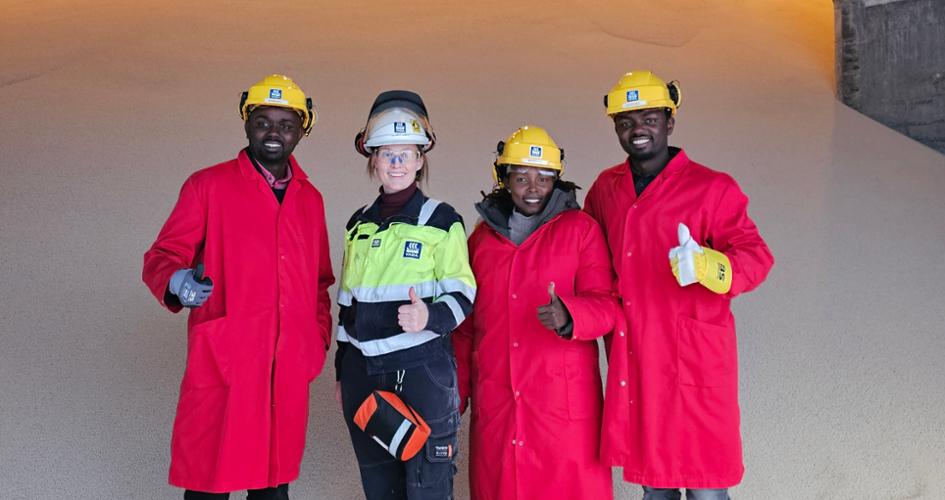Read in
Africa’s food and agriculture market could reach US$1 trillion, up from US$280 billion in 2023, with over US$60 billion spent on food imports yearly. There is increasing realization that much of this food could be produced locally on the continent, creating jobs and opportunities for African youth. In many ways, one unique aspect of Africa’s demographic profile – its large youth population — could be the answer to securing the continent’s food security.
Yara East Africa, in line with Yara’s commitment to a nature-positive food future on the continent, launched the Yara Shujaa Knowledge Exchange. The initiative — targeted to youth smallholder farmers between the ages of 18 and 35 — aims to facilitate knowledge exchange of sustainable farming techniques, and to benchmark best practices. During the one-week long program participants are given an in-depth look at aspects of the food value chain across production, processing and distribution. The program also covers topics like regenerative agriculture, soil health, and food value chains.
The first participants of the program are Kenyan farmers Janet “Farm Girl” Toroitich (30 years old), Rogers “Mr Agriculture” Kirwa (32 years old), and Ronald Diang’a (31 years old). During their week in Oslo the three farmers visited:
- Yara’s Porsgrunn fertilizer manufacturing plant, and research center
- A farm in Sandefjord and engaged with the local farming community
- A Norwegian coffee shop to learn about Norwegian coffee culture
- An Oslo food market, and grocery stores to explore the agri-value chain
The trio also visited Yara’s headquarters where they met with Yara CEO Svein Tore Holsether, members of Yara’s Global Innovation; Food Value Chain, and Yara Regenerative Agriculture teams.
‘The future is in the youth’
Svein Tore Holsether, speaking during a panel discussion with the Shujaa, said he believes that Africa has the potential to become the major food producer in the world, based on its arable land and population growth. “The only area that really has the potential to increase food production enough to supply the growing world population is Africa,” he said. If Africa is to exploit its $60-billion agriculture business opportunity, he believes, it is crucial to get young people engaged in agriculture and farming.
“If we are to turn this into a business at scale, if we are to drive the technology to scale, we need to get young people engaged. Farming now and in the future is very different from farming in the past. The future is really in the youth, there’s no doubt about the future potential of agriculture as a business.”
William Ng’eno, Country Manager Yara East Africa – Kenya, Uganda, explains that the agricultural sector in East Africa faces significant hurdles, with the average age of farmers ranging between 50 and 60 years old, and small-scale producers dominating, coupled with rain-fed crop production.
“This poses challenges to Kenya’s national efforts in achieving food security and fostering community prosperity through increased employment opportunities and household incomes. Suboptimal crop yields and a lack of value addition exacerbate these challenges,” says William.
“Recognizing agriculture as the cornerstone of East African economies, there is a concerted effort to engage more young people in the agricultural sector, aiming for transformative outcomes including employment creation, enhanced natural resource management, increased productivity, and innovation. The imperative of involving youth in agriculture cannot be overstated. The Shujaa Exchange program, launched three years ago, aims to highlight the successes of young people within the region, facilitating skills development and knowledge-sharing among youth across continents,” he adds.
Insights from the exchange program
Janet says one of the main takeaways of the program has been how Norwegian farmers are willing to pay for extension services, and how these have a significant impact on yields. She explains that the program has made her appreciate that knowledge and soil health are among a farmer’s most important assets. “The day a farmer realizes that farming should be done from this perspective is when they start the shift to sustainable agriculture.”
Seeing Norwegian farmers’ market-driven approach to farming was one of the highlights of the program for Ronald. Norwegian farmers generally practice contract farming, where production is carried out according to an agreement between a buyer and farmers. In Kenya, Ronald explains, most smallholder farmers generally produce first, and then find a buyer to sell to after harvest.
“I was more amazed at their ability to track and trace their produce from farm throughout the food value chain. I don’t know where my produce ends up. That was quite fascinating to me,” he says.
A recurring topic during the Shujaa interaction with Norwegian farmers and Yara staff was regenerative agriculture. Yara has been pioneering regenerative agriculture practices in Kenya, coupled with soil testing at its knowledge centers around the country. Ronald explains that there is a realization by Kenyan farmers on the need to preserve their soils. “It’s a topic that is slowly coming up in discussions among farmers, their soil is getting less fertile and becoming less productive, and that’s spurring interest in regenerative practices,” he says.
During the Shujaa trip to the fertilizer factory, and research center in Porsgrunn, Yara scientists emphasized the importance of the research being done on Yara fertilizer to make sure that when used in the right way, it will both increase productivity and preserve the soil.
“Visiting Yara Porsgrunn made me appreciate the crucial role fertilizer plays in achieving food security, and why it is particularly important to optimize fertilizer use to get higher yields,” says Rogers.
Looking back at the program, the Shujaa agree that with a combination of regenerative agricultural practices that preserve soil, good nutrient stewardship, and a market-driven approach, agriculture can be profitable.



